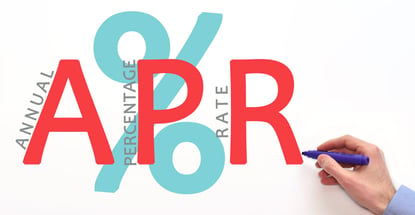When you’re shopping for a new credit card, you probably pay close attention to the annual percentage rates (APR) of the cards you’re considering. The APR is important because if you choose to carry a balance from one month to the next, the APR is used to determine the cost of servicing your debt.
What you may not realize, however, is that your APR can possibly change over time. Whether your credit card features a fixed APR, meaning it likely won’t change, or a variable APR, meaning it may change, there’s always a chance the card issuer could someday make an adjustment.
The type of interest rate you secure, however, determines whether the card issuer has to give you a heads up about an impending rate change.
Variable APRs Fluctuate, Fixed APRs Don’t
A variable APR is tied to an index, like the prime rate. The prime rate, which is published in the Wall Street Journal, is based on the federal funds rate, which is set by the Federal Reserve.
Most credit cards and some loans feature variable APRs, meaning they can change or “vary.” Think of the federal funds rate as what banks pay for borrowing money, which is then lent to you in one form or another.
From time to time, you may hear on the news that “the Fed,” short for the Federal Reserve, is raising or lowering interest rates. When this happens, there’s a chance your variable rate credit cards could be affected because the rate used to determine your APR may go up. If it costs banks more to borrow money, they may pass that added cost to you in the form of a higher APR.

Check your credit card terms to see whether your APR fluctuates with the prime rate. Photo source: primerates.com
Fixed-rate credit cards, on the other hand, feature APRs that don’t automatically change when other index rates change. However, while the APR of fixed-rate cards may not change as frequently, that doesn’t mean your APR will never adjust. Most credit card agreements include language that allows card issuers to change your rate on either fixed or variable APR accounts.
With a fixed APR, your credit card issuer must send you a notice at least 45 days before adjusting your rate. The card issuer must also give you an opportunity to opt out of the rate increase.
This sounds great, but if you exercise your right to opt out, the card issuer will likely exercise its right to close your account. Keep that in mind if you ever receive notice of a rate increase.
Assuming you don’t opt out, APR changes on fixed-rate cards often apply only to new purchases, not existing credit card balances. This is thanks to a federal law passed in 2009 known as the CARD Act, which all but eliminated retroactive interest rate increases. However, if you start missing your payments, federal law still allows retroactive rate increases to occur, even on fixed-rate cards. Nothing good ever happens when you miss credit card payments.
How Often Can a Variable Rate Change?
If your APR is variable and tied to an index, like the prime rate, then your rate can adjust any time that index rate changes. You can check your credit card agreement or call the customer service number on the back of your credit card to determine if such changes could apply to your account, and how often.
Many variable rate credit cards are based on the prime rate plus some added margin. For example, your credit card agreement may specify that your rate is prime + 10%. So, if the prime rate is 4.75%, your current credit card APR would be 14.75% (4.75% + 10%).
In addition to index rate fluctuations, your rate may adjust under any of the following circumstances:
- A promotional or teaser rate on your account expires
- You’re at least 60 days late on your minimum payments
- The condition of your overall credit deteriorates over time
Whether you’re using a fixed rate or a variable rate card, the issuer ultimately has the right to change your rate. The difference comes down to notification and the ability to opt-out of a rate increase.
Do Variable Interest Rates Ever Go Down?
Because many variable APRs are tied to the prime rate, your card’s interest rate could decrease when the prime rate goes down. When the Federal Reserve cuts rates, it lowers the federal funds rate.
So, if the Fed cuts rates, you may see the variable APR on your credit card go down shortly thereafter. Building off this example, imagine the Fed cuts rates and the prime rate drops to 4.5% as a result.
If your variable rate is still prime + 10%, then your new APR could fall to 14.5% (4.5% + 10%). It’s not much, but lower is always better.
If you’re carrying a balance on your credit card, a rate drop can help you save money. However, there’s also another way to potentially get a lower rate on your existing credit card, aside from crossing your fingers and hoping the prime rate goes down.
You can ask your card issuer for a lower APR. This is informally referred to as a policy adjustment.
To negotiate a lower rate with your card issuer, you simply need to pick up the phone and make a call. It may help to do a little homework first. You should definitely check your credit reports and credit scores to make sure your credit is error-free and in good shape.

You can check your credit report for free from each bureau once a year at AnnualCreditReport.com.
Aside from checking your credit, it also helps to know what other card issuers are offering. If you can reference low interest rate cards you found online or perhaps pre-screened offers you received in the mail, it may improve your odds of securing a lower APR.
No credit card issuer wants to lose a good customer to a competing issuer, which may be a reason it would lower your APR as a result of you asking.
Is a Fixed or Variable APR Better?
The rate on your credit card may not matter if you use the account responsibly. As long as you pay your balance in full each month, the interest rate becomes meaningless because you’re not going to be paying any interest.
When you carry a balance on your credit card, however, the picture changes. In this scenario, it’s better to focus on securing the lowest rate possible, regardless of the type.
Advertiser Disclosure
CardRates.com is a free online resource that offers valuable content and comparison services to users. To keep this resource 100% free, we receive compensation for referrals for many of the offers listed on the site. Along with key review factors, this compensation may impact how and where products appear across CardRates.com (including, for example, the order in which they appear). CardRates.com does not include the entire universe of available offers. Editorial opinions expressed on the site are strictly our own and are not provided, endorsed, or approved by advertisers.




![9 Best Fixed-APR Credit Cards & Alternatives ([updated_month_year]) 9 Best Fixed-APR Credit Cards & Alternatives ([updated_month_year])](https://www.cardrates.com/images/uploads/2020/01/Best-Fixed-APR-Credit-Cards.jpg?width=158&height=120&fit=crop)
![APR vs. Interest Rate: Is There a Difference? ([updated_month_year]) APR vs. Interest Rate: Is There a Difference? ([updated_month_year])](https://www.cardrates.com/images/uploads/2019/11/APR-vs-Interest-Rate-Feat.jpg?width=158&height=120&fit=crop)

![What is Credit Card APR? 9 Best 0% APR Cards ([updated_month_year]) What is Credit Card APR? 9 Best 0% APR Cards ([updated_month_year])](https://www.cardrates.com/images/uploads/2017/05/what-is-apr.jpg?width=158&height=120&fit=crop)
![What is a Good Credit Card APR? 5 Best Low APR Cards ([updated_month_year]) What is a Good Credit Card APR? 5 Best Low APR Cards ([updated_month_year])](https://www.cardrates.com/images/uploads/2017/11/good-apr2.png?width=158&height=120&fit=crop)
![How to Calculate APR on a Credit Card ([updated_month_year]) How to Calculate APR on a Credit Card ([updated_month_year])](https://www.cardrates.com/images/uploads/2015/11/CalculateAPR-1--1.png?width=158&height=120&fit=crop)
![6 Great Reasons to Use a 0% APR Deal ([updated_month_year]) 6 Great Reasons to Use a 0% APR Deal ([updated_month_year])](https://www.cardrates.com/images/uploads/2022/05/0-APR-Deal.jpg?width=158&height=120&fit=crop)
![6 Longest 0% APR Balance Transfer Cards ([updated_month_year]) 6 Longest 0% APR Balance Transfer Cards ([updated_month_year])](https://www.cardrates.com/images/uploads/2023/09/Longest-0-APR-Balance-Transfer-Cards.jpg?width=158&height=120&fit=crop)